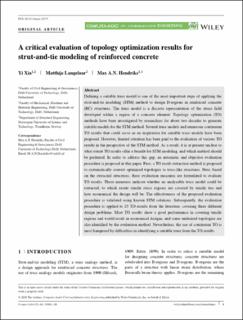| dc.contributor.author | Xia, Yi | |
| dc.contributor.author | Langelaar, Matthijs | |
| dc.contributor.author | Hendriks, Max | |
| dc.date.accessioned | 2021-04-08T08:48:21Z | |
| dc.date.available | 2021-04-08T08:48:21Z | |
| dc.date.created | 2020-05-07T14:35:56Z | |
| dc.date.issued | 2020 | |
| dc.identifier.citation | Computer-Aided Civil and Infrastructure Engineering. 2020, 35 (8), 850-869. | en_US |
| dc.identifier.issn | 1093-9687 | |
| dc.identifier.uri | https://hdl.handle.net/11250/2736780 | |
| dc.description.abstract | Defining a suitable truss model is one of the most important steps of applying the strut‐and‐tie modeling (STM) method to design D‐regions in reinforced concrete (RC) structures. The truss model is a discrete representation of the stress field developed within a region of a concrete element. Topology optimization (TO) methods have been investigated by researchers for about two decades to generate suitable models for the STM method. Several truss models and numerous continuum TO results that could serve as an inspiration for suitable truss models have been proposed. However, limited attention has been paid to the evaluation of various TO results in the perspective of the STM method. As a result, it is at present unclear to what extent TO results offer a benefit for STM modeling, and which method should be preferred. In order to address this gap, an automatic and objective evaluation procedure is proposed in this paper. First, a TO result extraction method is proposed to systematically convert optimized topologies to truss‐like structures. Next, based on the extracted structures, three evaluation measures are formulated to evaluate TO results. These measures indicate whether an analyzable truss model could be extracted, to which extent tensile stress regions are covered by tensile ties and how economical the design will be. The effectiveness of the proposed evaluation procedure is validated using known STM solutions. Subsequently, the evaluation procedure is applied to 23 TO results from the literature, covering three different design problems. Most TO results show a good performance in covering tensile regions and would result in economical designs, and some undesired topologies are also identified by the evaluation method. Nevertheless, the use of continuum TO is most hampered by difficulties in identifying a suitable truss from the TO results. | en_US |
| dc.language.iso | eng | en_US |
| dc.publisher | Wiley | en_US |
| dc.rights | Navngivelse 4.0 Internasjonal | * |
| dc.rights.uri | http://creativecommons.org/licenses/by/4.0/deed.no | * |
| dc.title | A critical evaluation of topology optimization results for strut‐and‐tie modeling of reinforced concrete | en_US |
| dc.type | Peer reviewed | en_US |
| dc.type | Journal article | en_US |
| dc.description.version | publishedVersion | en_US |
| dc.source.pagenumber | 850-869 | en_US |
| dc.source.volume | 35 | en_US |
| dc.source.journal | Computer-Aided Civil and Infrastructure Engineering | en_US |
| dc.source.issue | 8 | en_US |
| dc.identifier.doi | 10.1111/mice.12537 | |
| dc.identifier.cristin | 1809814 | |
| cristin.ispublished | true | |
| cristin.fulltext | original | |
| cristin.qualitycode | 1 | |

